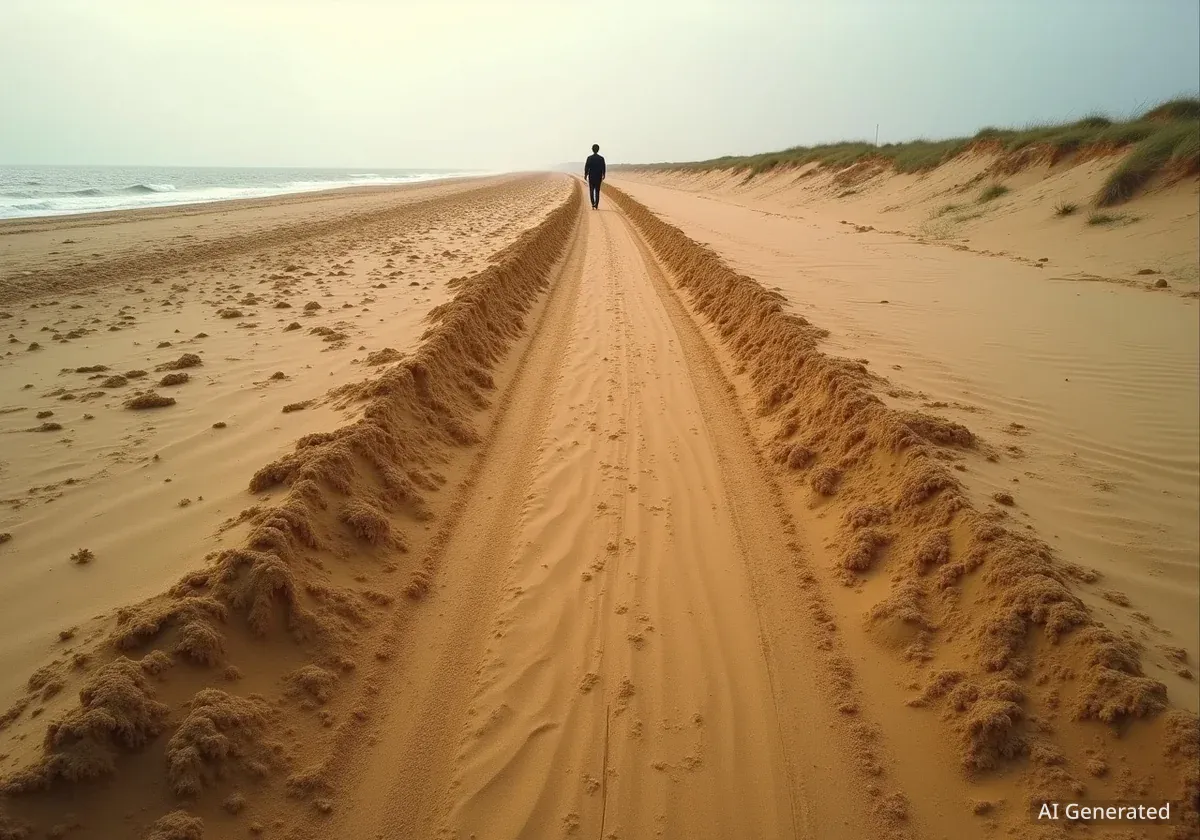A popular coastal path in Crosby has become a source of growing concern for residents, as vast quantities of wind-blown sand have buried the walkway, creating hidden dangers and rendering it inaccessible. Campaigners are urging Sefton Council to take action, warning that submerged railings, signposts, and unseen drops pose a significant risk to the public.
Key Takeaways
- The coastal promenade between Waterloo and Crosby Coastal Park is almost entirely covered by sand dunes.
- Local campaigners report hidden hazards, including buried fences, signposts, and sudden drops, making the area dangerous for visitors.
- The path is no longer accessible for wheelchair users, parents with buggies, or those with mobility issues.
- Sefton Council states it has removed thousands of tonnes of sand this year but describes the sand accumulation as an ongoing natural process.
- A dispute continues over potential solutions, including an offer from a local firm to clear the sand for free.
A Promenade Lost Under Sand
The promenade at Crosby, constructed in the early 1970s, was once a flat and safe route offering clear sea views for families, cyclists, and walkers. Today, much of this civic feature has vanished beneath mounds of sand that have migrated from the beach, in some places reaching above head-height.
During a site visit, the extent of the sand coverage was clear. Metal railings designed for safety are now almost completely submerged, official signage is barely visible, and even one of Antony Gormley’s famous Iron Men statues is buried up to its neck. The paved path is now just a memory under the dunes.
A Natural Process
According to local campaigners and environmental observations, the issue has worsened over the years. A receding high tide line means the beach sand stays dry for longer periods, allowing the wind to carry it inland onto the promenade. These are not natural dunes but man-made mounds formed from this wind-blown sand.
Hidden Dangers and Accessibility Barriers
For long-time residents and campaigners Christopher and Linda Wolstenholme, the slow burial of the path is a major safety issue. They lead the “Save the Promenade!” campaign, which aims to raise awareness and pressure the council for a solution.
“It’s dangerous now,” Linda Wolstenholme explained. “There are signposts eight feet tall and only the tops stick out of the sand. You’ve got bare poles, half-submerged fencing, and drops you can’t see.”
Beyond the immediate physical risks, the sand has created a significant accessibility barrier. The path, once a vital route for everyone to enjoy the coastline, is now unusable for many.
“Then there’s the issue of accessibility, because if you’re a wheelchair user or a mum with a baby and a buggy, the coastal path is completely cut off to you,” Mrs. Wolstenholme added.
Council Action and Ongoing Challenges
Sefton Council has acknowledged the problem and stated that its teams are actively managing the site. The scale of the task, however, is immense.
A spokesperson for Sefton Council commented on their efforts: “Our Green Sefton team regularly monitors and inspects the coastline. We have removed thousands of tonnes of blown sand at Crosby Coastal Park just this year alone to clear paths as much as possible with the resources available.”
A Monumental Task
The council has highlighted that the sand build-up is a result of natural coastal processes occurring over tens of thousands of years. They estimate that a full-scale operation to lower the beach level and clear the path would involve moving millions of tonnes of sand.
This ongoing natural process presents a significant financial and logistical challenge for local authorities, a situation mirrored in coastal communities across the United Kingdom struggling to maintain infrastructure against erosion and climate change.
A Dispute Over Solutions
The “Save the Promenade!” campaign has actively sought solutions. In 2022, the group submitted a petition to local councillors, which included a unique proposal from a local construction firm. The company offered to clear the sand from the path at no cost to the council, on the condition that it could keep the removed sand for recycling.
However, Sefton Council officials declined the offer. They cited concerns that the work would be disruptive to local residents and could negatively impact sensitive coastal habitats. Campaigners remain unconvinced by this reasoning, stating that residents have not been formally consulted on the matter.
A Proposed Compromise
Chris Wolstenholme has suggested an alternative approach that could serve as a compromise. He believes a previous strategy attempted by the former Coast and Country service should be revisited.
“A possible compromise solution would be to explore again the attempt to re-profile the dunes on the beach, reducing the height of the ones looming over the path on the promenade, and fencing them on the seaward side of the beach to protect them,” Mr. Wolstenholme said.
He also recommended seeding the area with Marram grass and other suitable vegetation, which is a common and effective method for stabilising dunes and reducing wind-blown sand.
Preserving a Piece of Civic Heritage
For the campaigners, the fight is about more than just clearing a path; it is about preserving a piece of local history and ensuring public access to a beloved community asset.
“This promenade was built by the old Crosby Borough Council and local residents paid for it. It was their pride and an important piece of civic heritage,” said Linda Wolstenholme.
The group remains in dialogue with Sefton Council, determined to find a workable solution that balances environmental concerns with public safety and accessibility. “We just want to ensure that future generations are able to enjoy it too,” she concluded.





